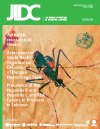Osteomyelitis in leukocyte adhesion deficiency type 1 syndrome
DOI:
https://doi.org/10.3855/jidc.387Keywords:
Leukocyte adhesions deficiency, Bone marrow transplantation, OsteomyelitisAbstract
Leukocyte adhesion deficiency type 1 (LAD-1) is a rare, inherited immunodeficiency that affects one per million people yearly and usually presents with recurrent, indolent bacterial infections of the skin, mouth, and respiratory tract and impaired pus formation and wound healing. A 13-year-old girl diagnosed LAD-I at the age of 7 years was brought to the Immunology, Asthma and Allergy Research Institute, Tehran University of Medical Sciences, because of a draining plaque on the left leg for 2.5 years. She had recurrent skin infections and had been treated with repeated courses of different antibiotic combinations, with temporary responses, since 5 years of age. Examination revealed a 7 × 8 cm minimally erythematous hyperpigmented plaque with multiple draining sinuses on the left leg. Tissue culture yielded Pseudomonas aeruginosa. Flow cytometry showed CD18 (18.79%), CD11a (51.59%), CD11b (18.61%) and CD11c(10.60%). A plain radiography of the left leg revealed osteomyelitis. It is highly suggested that patients diagnosed mild to moderate LAD-1 with recurrent skin infection and simultaneous weak response to conventional therapy undergo (BMT) marrow transplant to prohibit subsequent life-threatening complications.
Downloads
Published
How to Cite
Issue
Section
License
Authors who publish with this journal agree to the following terms:
- Authors retain copyright and grant the journal right of first publication with the work simultaneously licensed under a Creative Commons Attribution License that allows others to share the work with an acknowledgement of the work's authorship and initial publication in this journal.
- Authors are able to enter into separate, additional contractual arrangements for the non-exclusive distribution of the journal's published version of the work (e.g., post it to an institutional repository or publish it in a book), with an acknowledgement of its initial publication in this journal.
- Authors are permitted and encouraged to post their work online (e.g., in institutional repositories or on their website) prior to and during the submission process, as it can lead to productive exchanges, as well as earlier and greater citation of published work (See The Effect of Open Access).








